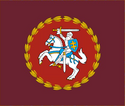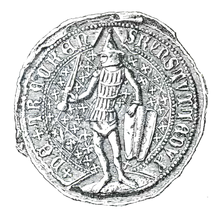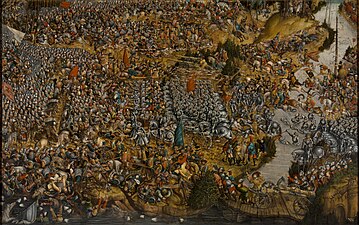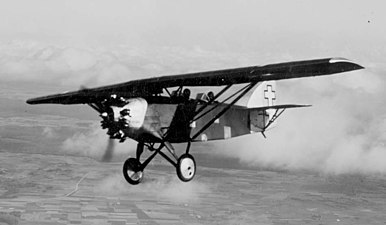Lithuanian Armed Forces
| Lithuanian Armed Forces | |
|---|---|
| Lietuvos ginkluotosios pajėgos | |
War time only: MINUSMA | |
| Ranks | Lithuanian military ranks |
 |
| Lithuanian Armed Forces |
|---|
| Components |
| Administration |
| Personnel |
| Equipment |
| History |
|
| Lithuania portal |
The Lithuanian Armed Forces (Lithuanian: Lietuvos ginkluotosios pajėgos) are the military of Lithuania. The Lithuanian Armed Forces consist of the Lithuanian Land Forces, the Lithuanian Naval Force, the Lithuanian Air Force and the Lithuanian Special Operations Force. In wartime, the Lithuanian State Border Guard Service (which is under the supervision of the Ministry of the Interior in peacetime) becomes part of the Lithuanian Armed Forces. A special security department handles VIP protection and communications security.
The purpose of the Lithuanian Armed Forces are to be the principal deterrent against any security threat to the nation. Lithuania's defence system is based on the concept of "total and unconditional defence" mandated by Lithuania's National Security Strategy. The goal of Lithuania's defence policy is to prepare their society for general defence and to integrate Lithuania into Western security and defence structures. The Ministry of National Defence is responsible for combat forces, search and rescue, and intelligence operations.[4]
Male conscription is in place since 2015, when it was reinstated after being ended in 2008, due to concerns about the geopolitical environment in light of the Russo-Ukrainian War.[5]
In early 2022, Lithuania's defence budget for 2022 was approximately €1.05 billion,[1][c] but it was increased to €1.5 billion on 17 March 2022.[6]
History
Grand Ducal Lithuanian Army

The Lithuanian military originates in the Grand Ducal Lithuanian Army, active from the 13th century to 1795.[7] After the Union of Lublin in 1569, the Lithuanian Army remained equal to the Polish Crown army in the military of the Polish–Lithuanian Commonwealth until the Third Partition in 1795. The Grand Ducal Lithuanian Army fought in many major battles, such as the Battle of Blue Waters (1362/63), Battle of Grunwald (1410), Battle of Orsha (1514) and Battle of Kircholm (1605).
Similarly to other
13th century
From the 12th century's end and into the 13th century, Lithuania frequently went to war against the western and southwestern
Although the Germans initially had superior weaponry in the 13th century, the Lithuanians won the Battles of
14th century
Over the 14th century, the Teutonic and Livonian orders organised raids into Lithuania.
Meanwhile on the other side of Lithuania, the Golden Horde's army was destroyed in the Battle of Blue Waters (1362-1363).[7] In 1368, 1370, and 1372, the Lithuanian Grand Duke Algirdas led the Grand Ducal Lithuanian Army on military expeditions against Muscovy.[7] However, the Battle of the Vorksla River (1399) was a decisive victory for the Golden Horde.[7]
-
medieval Europe
15th century
Finally, the German Teutonic Order was crushed in the Battle of Grunwald (1410) (known as Battle of Žalgiris in Lithuanian historiography), which was the largest Middle Age battle in Central and Eastern Europe.[7] In this key battle, the Lithuanian Army was led by Vytautas the Great.[7] Under him, the Lithuanian Army attacked the lands of the Republics of Pskov, in 1426, and Novgorod, in 1428.[7] The Grand Duchy of Lithuania had internal civil wars in the first half of the 15th century.[7] The Lithuania Army engaged in biological warfare already in 1422, when it catapulted manure made from infected victims into an opposing Bohemian town as part of the Hussite Wars.[10] In 1435, Sigismund Kęstutaitis' army defeated the opposing army, which included troops of the Livonian Order, led by Švitrigaila in the Battle of Wiłkomierz.[7]
16th century
This century was marked by war of Lithuania against Muscovy and the Crimean Khanate, against whom they won the Battle of Kletsk in 1506.[7] The strengthening Grand Duchy of Moscow starting in the late 15th century waged unceasing wars over Lithuania's eastern territories.[7] In 1514, during the fourth war, the Lithuanians triumphed over the numerically larger Muscovite army in the famous Battle of Orsha.[7] However, Lithuania lost a part of its eastern lands, most notably the strategically important fortress of Smolensk.[7] The Grand Ducal Lithuanian Army fought against Muscovy in the Livonian War and won against the Muscovite army, twice its size in the Battle of Ula in 1564.[7] Three years into the Livonian War, the Treaty of Vilnius.[9] made Livonia part of Lithuania in 1561 with the Union of Lublin concluded in 1569.[9] In the late 1570s and early 1580s, the Lithuanian and Polish armies cooperated in Stephen Báthory's incursions into Russia.[7]
-
The victory of the Polish-Lithuanian forces over theGrand Duchy of Moscow at the Battle of Orshain 1514
-
Modern reconstruction of the Lithuanian fighters from the 14-15th century
17th century
The 17th century was marked by wars against Sweden, the
The Commonwealth's military weakness in the middle and late 17th century was evidenced in the Deluge.[7] In 1655, the much-smaller Lithuanian army could not defend the Lithuanian capital of Vilnius against Muscovite attack.[7] This was the first time that Vilnius was occupied by a foreign state.[9] The Swedish and Muscovite armies occupied large parts of Lithuania.[7] Nevertheless, Lithuania succeeded in holding out and liberated Vilnius, Kaunas, Samogitia and the eastern Voivodeships, except for Smolensk Voivodeship and other parts.[7] Militarily speaking, the Grand Duchy of Lithuania was weakening however.[7]
18th century

During the
The Polish and Lithuanian armies put up a spirited fight against the
Interwar and post-war periods
| Date | Total number |
|---|---|
| 5 March 1919 | 3,000([11])
|
| 24 January 1920 | 28,903([12])
|
| 8 September 1920 | 27,802([12])
|
| 1 January 1921 | 43,996([13])
|
| 1 November 1924 | 13,241([14])
|
| 1 May 1926 | 7,894([14])
|
| 1 January 1928 | 16,483([15])
|
| 1 December 1934 | 19,784([15])
|
| 1 March 1938 | 25,655([16])
|
| 5 September 1939 | 37,027([17])
|
| 30 September 1939 | 89,470([17])
|
| 1 March 1940 | 31,895([18])
|
After Lithuania's
-
Lithuanian Renault FT-17 tanks in 1924
-
Lithuanian Army in 1938
-
Lithuanian design ANBO III aircraft from 1930s
Restoration and NATO

Following the
Lithuania applied for NATO membership in 1994 and eventually joined the alliance in 2004. It has modernised its armed forces and participated in various international missions including the NATO-led mission in Afghanistan.
Organization
Gold – headquarters

The President of Lithuania is the commander-in-chief of the Lithuanian Armed Forces according to the Constitution of Lithuania. Ministry of National Defence is directly responsible for the organisation of the defence system.[26] Chief of Defence (Lithuanian: Kariuomenės vadas) is subordinate to the Minister of National Defence. Defence Staff (Lithuanian: Gynybos štabas) of the Armed Forces is responsible for the preparation of defence and mobilisation plans.
The Lithuanian Armed Forces consist of the Lithuanian Land Force, Lithuanian Air Force, Lithuanian Naval Force, Lithuanian Special Operations Force and other units: Logistics Command, Training and Doctrine Command, Headquarters Battalion, Military Police. Directly subordinated to the Chief of Defence are the Special Operations Force and Military Police. The Reserve Forces are under command of the Lithuanian National Defence Volunteer Forces.
Lithuanian Land Force

The core of the Lithuanian Land Force structure is the
The Volunteer Forces form another brigade-size force, consisting of six territorial units. Other auxiliary units include Juozas Vitkus Engineer Battalion and Juozas Lukša Land Force Training Center.
The Lithuanian Land forces use equipment compatible with NATO standards. Since 2007, the standard assault rifle is the German
Lithuania has been restructuring its armed forces so that one-tenth of the Land Forces could at any given time be deployed for international operations, while half of the Land Forces would be prepared to deploy outside Lithuania's borders. The volunteers have already successfully participated in international operations in the Balkans, Afghanistan and Iraq.
In May 2023, the State Defence Council approved the plan to form an army division, based on the three army brigades.[28] The division-sized unit would have enhanced capabilities, including new tank, reconnaissance, engineering and artillery battalions.[28]
Lithuanian Air Force

The Lithuanian Air Force (LAF) is an integral part of the Lithuanian Armed Forces. The LAF is formed by professional military servicemen and non-military personnel. Units are located at various bases across Lithuania:
- Kaunas (Headquarters and the Airspace Surveillance and Control Command);
- Karmėlava (Air Space Control Centre);
- Nemirseta (providing basing for sea search and rescue detachment);
- Šiauliai (Zokniai Air Base, Air Force Armament and Equipment Repair Depot);
- Air Defence Battalion).[29]
The initial formation of the LAF was the 2nd transport squadron with the transfer of 20
Following the initial acquisitions, the LAF began its aircraft's modernisation by ordering three
Air space is patrolled by jet fighters from other

The Navy has over 600 personnel. The Navy consists of the Warship Flotilla, the Sea Coastal Surveillance System, the Explosive Ordnance Disposal (EOD) Divers Team, the Naval Logistic Service, Training Center and Maritime Rescue Coordination Center. The flotilla is the core component of the Navy and consists of the Mine Countermeasures Squadron, the Patrol Ships Squadron, and the Harbour Boats Group. The Navy uses patrol ships for coastal surveillance.
The four newly acquired Flyvefisken-class patrol vessels replaced the older Storm-class patrol boats and Grisha-class corvettes.
Special Operations Force

The Lithuanian Special Operations Force of Lithuanian Armed Forces has been in operation de facto since 2002 and it was established de jure on 3 April 2008, when amendments of National Defence System organisation and military service law came into force.[32] The Special Operations Force is formed from the Special Operations Unit.[33]
The Special Operations Force is responsible for
The Special Operations Force Squadron "Aitvaras" was deployed to Afghanistan on the Operation Enduring Freedom. From 2005 to 2006 its squadrons were on standby in NATO Response Force.[33]
International cooperation


Lithuania has been a member of
In 2009, to encourage regional cooperation, Lithuania joined the initiative to form the Lithuanian–Polish–Ukrainian Brigade.
NATO membership
Soon after the restoration of independence, Lithuania
Following the 2016 Warsaw summit, NATO Enhanced Forward Presence was deployed in the Baltic States with the multinational battalion battle group in Lithuania being led by Germany.
Cooperation between the Baltic States

Lithuania also cooperates with the two other Baltic states – Latvia and Estonia in several trilateral Baltic defence co-operation initiatives:
- Baltic Battalion (BALTBAT) – infantry battalion for participation in international peace support operations, headquartered near Riga, Latvia;
- Baltic Naval Squadron (BALTRON) – naval force with mine countermeasures capabilities, headquartered near Tallinn, Estonia;
- Baltic Air Surveillance Network (BALTNET) – air surveillance information system, headquartered near Kaunas, Lithuania;
- Joint military educational institutions: Baltic Defence College (BALTDEFCOL) in Tartu, Estonia, Baltic Diving Training Centre in Liepāja, Latvia and Baltic Naval Communications Training Centre in Tallinn, Estonia.[35]
In January 2011, the Baltic states were invited to join Nordic Defence Cooperation, the defence framework of the Nordic countries.[36] In November 2012, the three countries agreed to create a joint military staff in 2013.[37] Future co-operation will include sharing of national infrastructures for training purposes and specialisation of training areas (BALTTRAIN) and collective formation of battalion-sized contingents for use in the NATO rapid-response force.[38]
Foreign missions and operations
Lithuanian soldiers have taken part in international operations since 1993. From the summer of 2005 until 2014,
Since joining international operations in 1993, Lithuania has lost two soldiers. 1st Lt. Normundas Valteris fell in
Current operations (in 2022)
| Deployment | Organization | Operation | Personnel[1] |
|---|---|---|---|
| Central African Republic | EU
|
EUTM RCA | 2 |
| Iraq | NATO | NATO Mission Iraq | 2 |
| Mali | EU
|
EUTM Mali
|
2 |
| Mali | UN
|
MINUSMA
|
45 |
| Kosovo | NATO | KFOR | 1 |
| Ukraine | JMTG-U | 30 |
List of military equipment
-
JLTV
Ranks
See also
- Equipment of the Lithuanian Land Force
- Baltic Air Policing
- NATO Enhanced Forward Presence
 Lithuania portal
Lithuania portal
Notes
a. ^ The 23,000 is structured like this: 14,500 in the Army, 1,500 in the Air Force, 700 in the Navy, and 6,300 in other units. The other units includes the Logistics Support Command (1,400), Training and Doctrine Command (1,500), the Special Operations Force (unknown) as well as the battalions of HQ and Military Police (2,600).[40]
b. ^ The paramilitary includes 10,600 of the Riflemen's Union and 3,550 of the State Border Guard Service.[2]
c. ^ The number of 1.05 billion is without including military pensions. When the military pensions are included, the military budget reaches 1.12 billion.[2]
Citations
- ^ a b c d Hackett 2022, p. 124.
- ^ a b c Hackett 2022, p. 125.
- ^ a b Gynybos biudžetas, 2024, archived from the original on 28 June 2022, retrieved 6 February 2024
- ^ "Lietuvos Respublikos krašto apsaugos ministerija :: Titulinis" (PDF). Retrieved 24 December 2014.[permanent dead link]
- ^ Čepinskytė 2016.
- ^ LRT.lt 2022.
- ^ a b c d e f g h i j k l m n o p q r s t u v w x y z aa ab ac ad ae af ag ah ai aj ak al am an ao ap aq ar as at au av aw ax ay Gaidys, Arvydas; Knezys, Stasys; Spečiūnas, Vytautas. "Lietuvos Didžiosios Kunigaikštystės kariuomenė" (in Lithuanian). Visuotinė lietuvių enciklopedija. Retrieved 2 May 2021.
- Vilnius University Press: 15. Retrieved 21 June 2021.
- Vitkūnas, Manvydas (2011). "Kada lietuviai pradėjo kautis raiti?". Lituanistica. Lithuanian University of Educational Sciences: 59. Retrieved 21 June 2021.
- Vitkūnas, Manvydas (2011). "Kada lietuviai pradėjo kautis raiti?". Lituanistica.
- ^ a b c d e "Nuo seniausių laikų iki XX a. pradžios | Lietuvos kariuomenė". www.kariuomene.lt (in Lithuanian). Archived from the original on 25 October 2021. Retrieved 12 October 2021.
- ISBN 978-0-12-812055-2.
- ^ Vaičenonis 2002, p. 144.
- ^ a b Vaičenonis 2002, p. 150.
- ^ Vaičenonis 2002, p. 151.
- ^ a b Vaičenonis 2002, p. 152.
- ^ a b Vaičenonis 2002, p. 158.
- ^ Vaičenonis 2002, p. 170.
- ^ a b Vaičenonis 2002, p. 172.
- ^ Vaičenonis 2002, p. 146.
- ^ a b "Lietuvos ginkluotosios pajėgos 1918–1940" (in Lithuanian). Visuotinė lietuvių enciklopedija. Retrieved 2 May 2021.
- ^ a b "The fight for Lithuanian statehood. From ancient times to NATO". Archived from the original on 3 May 2021. Retrieved 3 May 2021.
- ^ "Tyrimų laboratorija". Modernizmasateiciai.lt (in Lithuanian). 3 February 2019. Retrieved 4 February 2022.
- ^ Knezys, Stasys. "Lietuvos liaudies kariuomenė". Visuotinė lietuvių enciklopedija (in Lithuanian). Retrieved 28 January 2022.
- ^ "Lietuvos ginkluotosios pajėgos po nepriklausomybės atkūrimo" (in Lithuanian). Visuotinė lietuvių enciklopedija. Retrieved 2 May 2021.
- ^ "Compulsory basic military service discontinued". Ministry of National Defence. Archived from the original on 26 June 2010. Retrieved 9 March 2009.
- ^ "Conscription notices to be sent to 37,000 men in Lithuania".
- ^ "Lietuvos Respublikos krašto apsaugos sistemos organizavimo ir karo tarnybos įstatymas" (in Lithuanian). Office of the Seimas of the Republic of Lithuania. Retrieved 2 May 2021.
- ^
"Valstybės sienos ir jos apsaugos įstatymas". Office of the Seimas of the Republic of Lithuania (in Lithuanian). 5 May 2000. Retrieved 28 August 2021.
- "Viešojo saugumo tarnyba". Universal Lithuanian Encyclopedia. Retrieved 11 August 2021.
- "Viešojo saugumo tarnyba".
- ^ a b Andrukaitytė, Milena (8 May 2023). "Lithuania's State Defence Council backs proposal to create army division". LRT. Retrieved 22 July 2023.
- ^ "Lithuanian Armed Forces :: Structure " Air Force". Ministry of National Defence, Republic of Lithuania. Archived from the original on 17 October 2014. Retrieved 24 December 2014.
- ^ "Lithuanian Armed Forces :: Structure " Navy". Ministry of National Defence, Republic of Lithuania. Archived from the original on 17 October 2014. Retrieved 24 December 2014.
- ^ "Lithuanian Armed Forces :: Structure " Navy " Command". Ministry of National Defence, Republic of Lithuania. Archived from the original on 17 October 2014. Retrieved 24 December 2014.
- ^ "Ministry of National Defence Republic of Lithuania". Archived from the original on 24 December 2014. Retrieved 24 December 2014.
- ^ a b c "Lithuanian Armed Forces :: Structure " Special Forces". Archived from the original on 8 August 2016. Retrieved 24 December 2014.
- ^ "Ministry of National Defence Republic of Lithuania :: News " News archives " News archive 2009 " News archive (2009–03)". Archived from the original on 22 December 2017. Retrieved 24 December 2014.
- ^ "Baltic Defence Co-operation". Estonian Ministry of Foreign Affairs. January 2002. Archived from the original on 5 August 2011. Retrieved 11 August 2012.
- ^ "Nordic Countries Invite Baltics to Join Defence Co-operation Framework". Estonian Ministry of Foreign Affairs. 21 January 2011. Archived from the original on 8 June 2012. Retrieved 11 August 2012.
- ^ "Joint Baltic Military Staff to Be Established". Estonian Public Broadcasting. 9 November 2012. Archived from the original on 11 November 2012. Retrieved 25 November 2012.
- ^ "Baltic Defence Ministers announced new defence cooperation initiatives". Ministry of National Defence, Republic of Lithuania. 12 December 2011. Archived from the original on 23 July 2012. Retrieved 11 August 2012.
- ^ "Lithuanian Armed Forces :: Multinational operations " In remembrance". Ministry of National Defence, Republic of Lithuania. Archived from the original on 18 October 2018. Retrieved 24 December 2014.
- ^ Hackett 2022, p. 124-125.
As of this edit, this article uses content from "Lithuanian Armed Forces", authored by Ministry of National Defence Republic of Lithuania, which is licensed in a way that permits reuse under the
Sources
- Čepinskytė, Agnė (6 June 2016). "Lithuania Reinstates Conscription: Implications on Security, National Identity, and Gender Roles". Foreign Policy Research Institute.
- Hackett, James, ed. (14 February 2022). "The 2022 Military Balance Chart". The Military Balance. 122 (1). ISSN 0459-7222.
- LRT.lt, BNS (17 March 2022). "Lithuania raises defence spending to 2.52 percent of GDP". LRT.
- Sytas, Andrius (23 June 2022). "Lithuania president eyes hike in defence spending to host more NATO troops". Reuters. Vilnius.
- Vaičenonis, Jonas (2002). "Lietuvos kariuomenės skaičiai 1920–1939 m." (PDF). Karo Archyvas (in Lithuanian). 17. Vilnius. Archived from the original (PDF) on 15 December 2022. Retrieved 1 August 2023.
Further reading
- The Military Strategy of the Republic of Lithuania
- Stefan Marx, 'Lithuania's Defence Structure,' Jane's Intelligence Review, September 1993, p. 407–409
External links
- Official website

- Official Ministry of National Defence Republic of Lithuania website
- Official Joint Headquarters of Lithuanian Armed Forces website
- Official YouTube channel of Lithuanian Armed Forces
- Official NATO Energy Security Center of Excellence website
- Official General Jonas Žemaitis Military Academy of Lithuania website














